VIEW BY CATEGORY:
Hi, we're Hunter and Sarah, a husband-and-wife, luxury wedding photography team. We’re also educators, helping other photographers build profitable and sustainable photography businesses.
MEET US
LOOKING FOR SOMETHING?
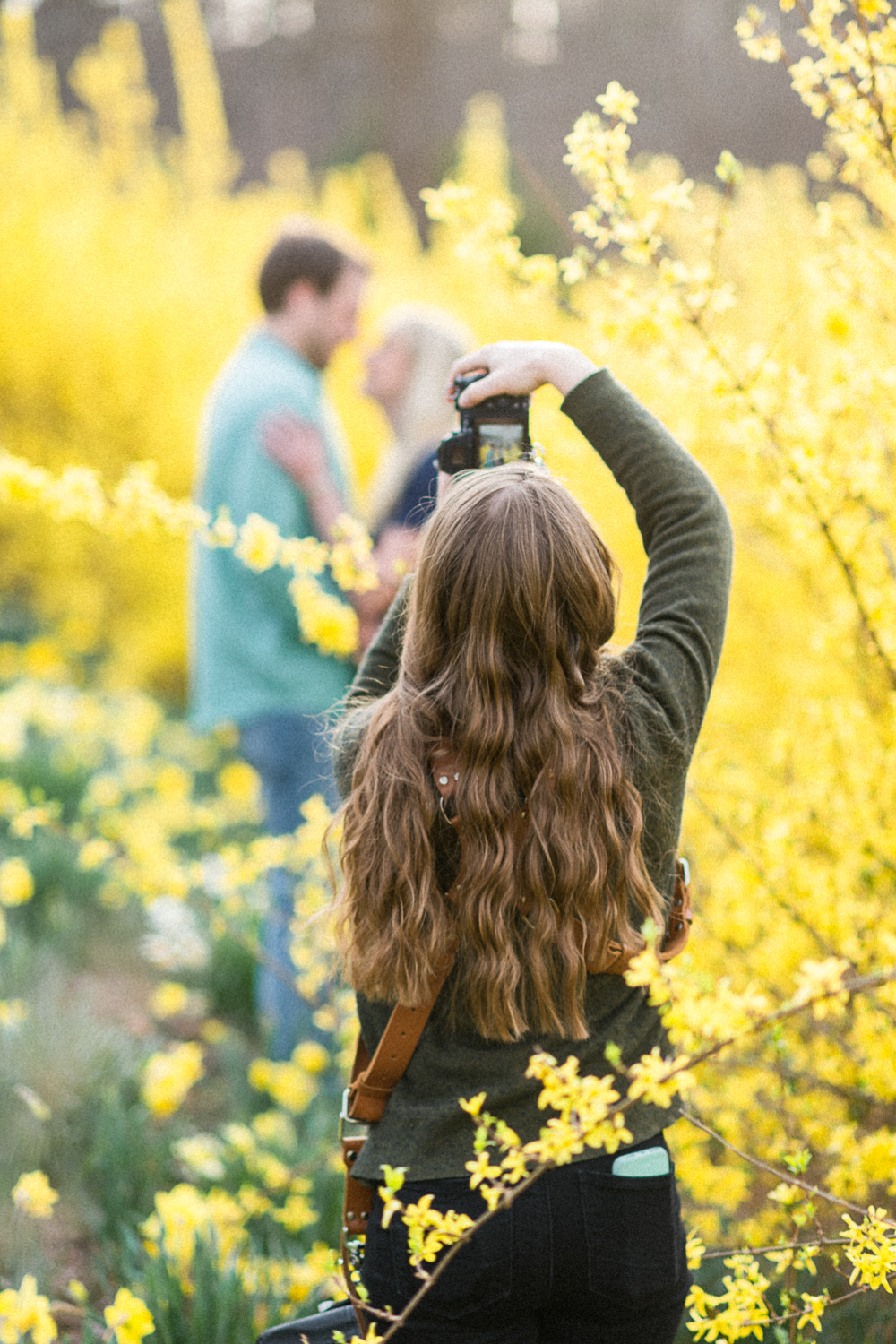
Camera Bag Essentials 0: Mirrorless or DSLR? Nikon D750 vs Z6 vs Z6ii
January 13, 2022
—
Hey photographers! Welcome to the very first part of our blog/video series, “Camera Bag Essentials”. The series is all about helping photographers at any stage of their business — whether just getting their first paid jobs, or in the thick of their first years as wedding photographers — think strategically about how to spend their hard-earned photography dollars!
This blog specifically (one of our most popular of ALL TIME) is all about deciding between a mirrorless and DSLR camera. Although we’re Nikon shooters ourselves, hopefully the advice in this blog — as well as the entire series — will be helpful even if you shoot Canon (Canon DSLR vs. Canon Mirrorless RP or R6), Sony, or anything else! Since Mirrorless vs. DSLR is such a foundational decision to all the other gear decisions, we decided this blog would be Part Zero in the series!
But First, A Little History
For most of the last decade, the Nikon D750 was, in our opinion, the top-of-the-line professional Nikon camera body, and the best fit for most professional portrait and wedding photographers. While Nikon has two higher-end DSLRs, we always felt like they were overkill for most wedding and portrait photographers. The Nikon D850 (and it’s mirrorless counterpart, the Nikon Z7/Z7ii) is double the price in exchange for a 45-megapixel sensor (honestly TOO big for most wedding and portrait needs), while the Nikon D6 (and the mirrorless Z9) costs 2X and weighs 3X, essentially in exchange for a smaller image sensor and a few extra frames per second. Unless you shoot for large-format print, sports or photojournalism, the D750-level was all you ever needed!
Then, in 2018, Nikon released its first iteration of mirrorless cameras. This was the first deviation from the F-mount DSLR for professional photographers since it stepped onto the digital scene with the Nikon D1 in 1999. This (along with Sony and Canon releasing their first professional mirrorless cameras around the same time) was a turning point in digital photography. Then, in 2020, Nikon released a long-overdue update to the D750, the Nikon D780, which took many of the technology upgrades from Nikon’s mirrorless cameras and applied them to the DSLR format. Finally, in the final days of 2020, Nikon began shipping the Z6ii, the much-anticipated update to the Z6.
But as a professional wedding and portrait photographer, you might find yourself asking which camera body is right for me? Since joining the program with us, almost all of our apprentices made the leap from crop-sensor to full-frame camera, and we talked them through the DSLR vs. mirrorless debate. Now, we want to make our research and considerations open to all photographers out there!
Plus, Sarah and I have the advantage of being intimately acquainted with both the Nikon D750, the Nikon Z6, and the Z6ii. I shot in the DSLR ecosystem for years with the D750 before switching to the mirrorless Z6ii, while Sarah has shot exclusively with the Z6 then the Z6ii for most of her professional career! While neither of us have personal experience with the D780, we thought that it would fit well into this discussion as the update to the D750. So without further ado, let’s compare these four cameras!
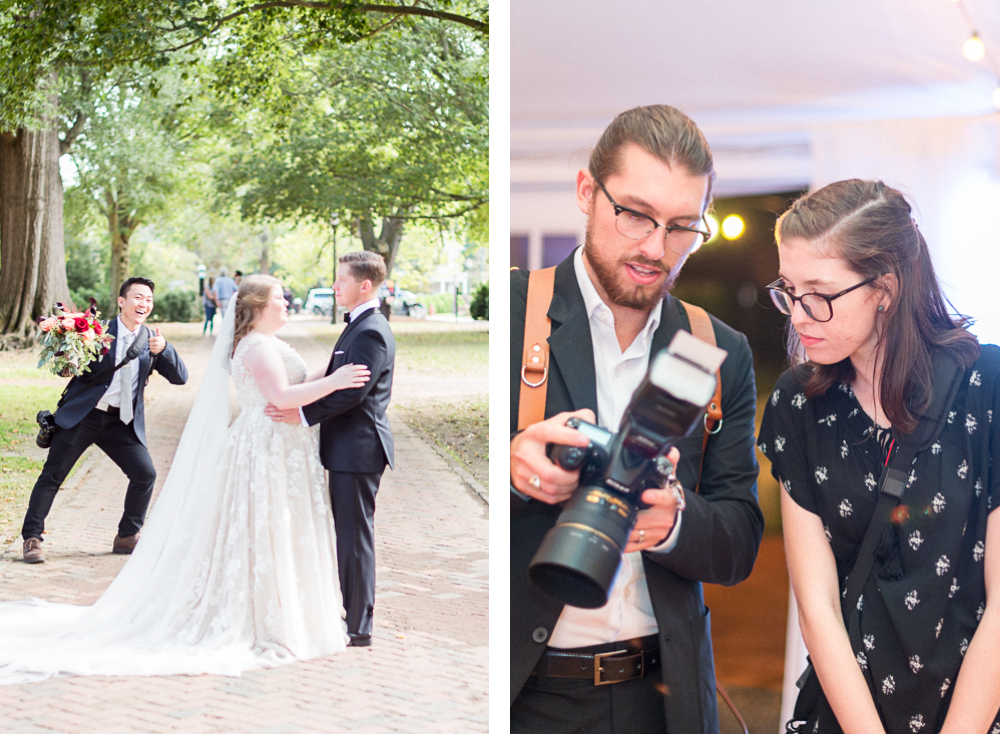
In 2019, two of our apprentices were upgrading to their first full-frame cameras. At the time, Caleb decided to go right for the mirrorless ecosystem with the Z6. But Kelly decided that the D750 was better for where she was in her business at the time, although she eventually upgraded to the Z6ii a couple of years later.
Basic Specs:
Let’s start with a few basic specs. If you’re not a huge camera gear nerd like I am, some of these specs might not mean anything on their own. So we’ve also written some commentary about what each spec might mean on a wedding day or on a portrait session!
Weight:
Nikon D750: 26.5 oz
Nikon D780: 29.7 oz
Nikon Z6: 25.4 oz (with FTZ Adaptor attached)
Nikon Z6ii: 26.4 oz (with FTZ Adaptor attached)
Conclusion: All of these cameras are fairly light, and weigh within 4 oz of each other, so weight isn’t much of a consideration. If you’ll be using Z-mount lenses with the Z6 or Z6ii and won’t need the FTZ adaptor (more on that later), the mirrorless lenses are ~4 oz lighter than the D750, about the weight of a deck of cards. Many lenses that we shoot with weigh more than all of these cameras! We’ll call this one a tie.
Silent Shutter:
Nikon D750: No
Nikon D780: Yes, in Live View mode
Nikon Z6: Yes
Nikon Z6ii: Yes
Conclusion: Although we don’t care much about a silent shutter 90% of the time, when we’re shooting in quiet, echoey churches or we’re taking photos during a prayer or other intimate moment, we’re grateful for the silent shutter! While I wouldn’t buy a new camera just for a silent shutter, it’s certainly nice at times! It’s a win for the D780, the Z6 and the Z6ii.

Especially during quiet moments like a First Look, it’s clutch to be able to shoot without distracting from the moment.
Sensor:
Nikon D750: 24.3 megapixels, native ISO 100- 12,800
Nikon D780: 24.5 megapixels, native ISO 100- 51,200
Nikon Z6: 24.5 megapixels, native ISO 100- 51,200
Nikon Z6ii: 24.5 megapixels, native ISO 100- 51,200
Conclusion: The Z6, Z6ii and D780 have the same image sensor. Although it’s slightly larger than the D750’s sensor and has a higher native ISO range, how often do you really need your ISO higher than 10,000? After a quick peek inside our primary Lightroom Catalog, of the 70,000+ photos we’ve delivered in the last 2 years, we’ve shot less than 50 above 10,000 ISO, and most of them were from the very specific lighting situation of shooting outside, at night, without flash. So we’ll call this one a tie as well.
Focus:
Nikon D750: 51-point autofocus system (covering the middle 20% of the frame)
Nikon D780: 51-point autofocus system OR 273-point auto-focus system in Live View
Nikon Z6: 273-point autofocus system (covering the entire frame)
Nikon Z6ii: 273-point autofocus system (covering the entire frame)
Conclusion: This is another area where the D780 almost catches up with the two mirrorless cameras. When shooting in Live View on the D780 (looking at the LCD screen instead of through the optical viewfinder eyepiece), the D780 is silent AND has full-frame auto focus, just like a mirrorless camera does at all times. The days of focus-with-the-middle-focal-point then recompose-the-image-to-put-your-subject-outside-the-focal-points are coming to an end. Victory goes to the Z6 and Z6ii, and to a lesser degree, the D780.
Battery Grip:
Nikon D750: Nikon MB-D16
Nikon D780: None exists
Nikon Z6: Nikon MBN10
Nikon Z6ii: Nikon MBN10
Conclusion: Although many photographers don’t care about a battery grip, I LOVE having a battery grip on my primary camera body. Although the grip does give me two batteries in my camera instead of one, it’s actually the ability to adjust my settings and use my camera’s focus and shutter-release buttons ALL on the bottom/side of the camera that I love the most! It has saved me a LOT of wrist pain over the years, even though it’ll adds 12 oz to a D750 and 11 oz to a Z6 or Z6ii. If a battery grip is a must-have for you like it is for me, the D780 is the only loser on this one.
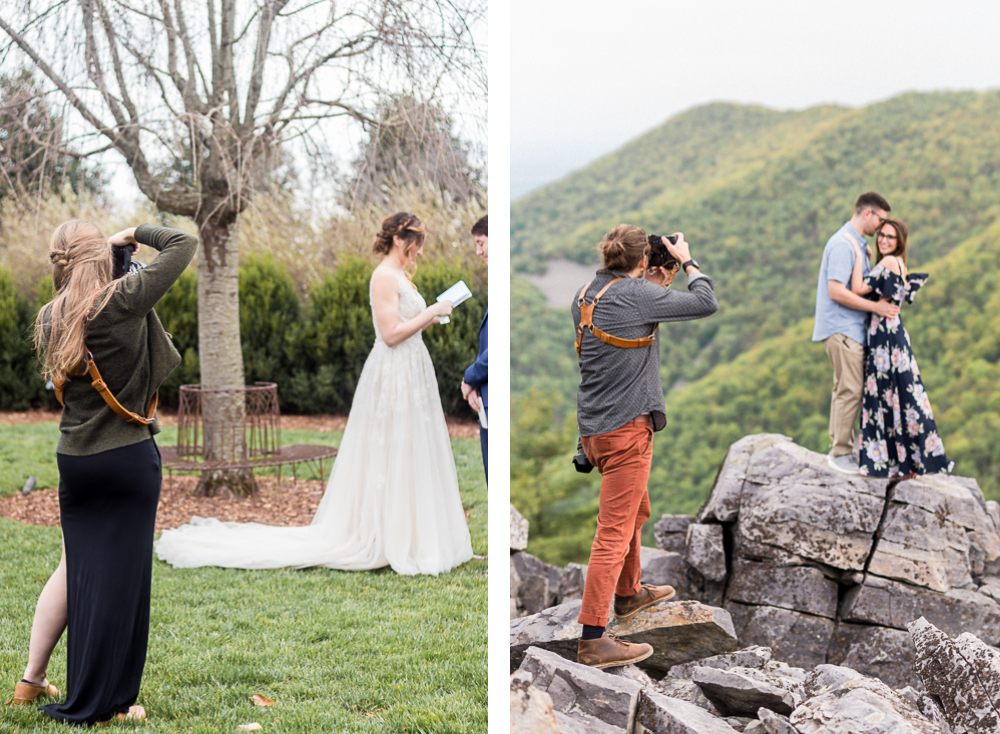
Notice the difference in our arm and wrist positions in these two photos, thanks to the battery grip on my D750. Trust me, your wrist straight-up-and-down is WAY more comfortable and healthy than bent over the top like Sarah’s, especially if you shoot with heavy lenses and on long wedding days. If you’re in it for the long-haul, you don’t want wrist pain!
Viewfinder:
Nikon D750: Optical viewfinder (using a mirror to look through the actual lens)
Nikon D780: Optical viewfinder (using a mirror to look through the actual lens)
Nikon Z6: Electronic viewfinder (looking at a digital rendering of what the lens sees)
Nikon Z6ii: Electronic viewfinder (looking at a digital rendering of what the lens sees)
Conclusion: This is one area where the mirrorless cameras are the hands-down winners. Photography newbies, old-school curmudgeons and luddites will all agree: an electronic viewfinder makes digital photography SO much easier that it’s practically cheating! When you look through the Nikon Z6 or Z6ii’s viewfinder (or its LCD screen, for that matter), you see exactly what the image will look like when you click the shutter. Adjustments to ISO, Aperture and Shutter Speed are shown as you make them, on your screens, NOT after you take a photo like with DSLR cameras.
While this is definitely still convenient for more advanced photographers, this will be a total game-changer for photographers just learning to shoot in manual mode. No more wildly adjusting your settings in a panic as your LCD screen shows completely-white or completely-black images. Your changes are shown to you live, meaning you have no excuse to ever accidentally shoot an over-exposed or under-exposed image again. The sheer convenience of the electronic viewfinder is what finally convinced me to switch from my D750 to a mirrorless camera
Another area where this is super clutch? Dark reception photography. When I used to shoot dark receptions with my D750, I was constantly straining my eyes to see what I was looking at, and couldn’t see my subject in full light until I clicked the shutter, my flash fired, and I looked at the image on my LCD screen. The dark ambient light meant that my subjects appeared SO dark when I was looking through my optical viewfinder. But not for someone using a mirrorless camera! When Sarah would shoot with her mirrorless during the sam reception, she would put her eye to her electronic viewfinder and see the image lit up, bright as day. But even if you don’t shoot dark receptions, this is a big win to the Z6 and Z6ii here!
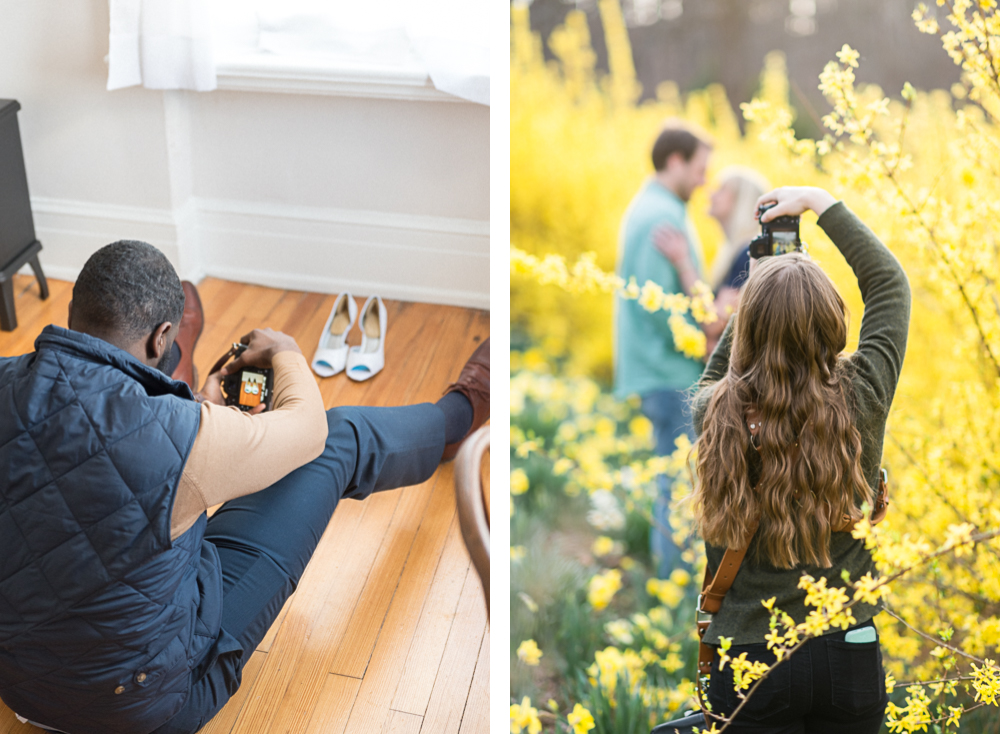
One of our Apprentices, Wes, was using Live View on his DSLR camera. However, once he clicked the shutter, the image itself might have looked totally different than what he was seeing in Live View! On Sarah’s Z6ii, she knows exactly what her images will look like when shooting with her camera’s LCD screen (or viewfinder).
Touch Screen:
Nikon D750: No
Nikon D780: Yes
Nikon Z6: Yes
Nikon Z6ii: Yes
Conclusion: All four of the cameras have LCD screens that tilt up and down, perfect for when holding the camera above your head or shooting from the hip. But only the D780, Z6 and Z6ii have touch-screens, which are handy when reviewing photos, or when shooting with the LCD screen. While shooting, you can tap anywhere on the screen and the camera will autofocus to that point, then take the image instantly. I personally don’t use this feature very often, but Sarah says it’s helpful for short people like her shooting above your head, and some of our younger, Gen-Z Apprentices seem to use this feature all the time! A small win for the D780, the Z6, and the Z6ii.
Banding/Distortion Glitches:
Nikon D750: None
Nikon D780: Most likely none
Nikon Z6: In certain artificial light situations, with silent shutter on
Nikon Z6ii: In certain artificial light situations, with silent shutter on
Conclusion: This is one area that Nikon obviously won’t be mentioning on their product pages, but we needed to mention. The Nikon Z6 and Z6ii are the first generations of Nikon mirrorless technology, and they have a few glitches that first-gen tech often has. First, when shooting in artificial light (so anytime you’re inside with the lights on) AND using silent shutter, you’ll need to watch out for “banding”. These look like horizontal gray bars running across the entire image, and they occur (basically) because your shutter speed is too close to the frequency of the light from the light bulbs.
Don’t worry too much about this, though, because if you do notice it, just turning off silent shutter will fix the problem. Ever since we realized that silent shutter was the root issue, we always take a series of test shots before indoor ceremonies (the one time when silent shutter is most important inside) to confirm whether or not any of the artificial light will cause banding. If it does, then we just “go loud” and prioritize good images over being silent.
We’ll also occasionally get some really strange distortion while shooting subjects in motion. While DSLR cameras capture motion distortion as a general blur, the Z6 and Z6ii sometimes capture it like a glitch in the matrix! This is also easy to avoid by keeping your shutter speed high when shooting subjects in motion, but you’ll need to look out for it. This is a very small win for the two DSLR cameras, since these issues are pretty easy to avoid once you know about them.

Notice the darker bands running up and down this raw image on the left. If you don’t notice them at first, look at the darker parts of the images above the string lights, or the gray-blue jacket the woman is wearing! On the right, a little hand shake caused this raw image to warp out on Sarah’s Z6!
Memory Card Slots:
Nikon D750: Two SD card slots
Nikon D780: Two SD card slots
Nikon Z6: One XQD/CFExpress card slot
Nikon Z6ii: One XQD/CFExpress card slot AND one SD card slot
Conclusion: While XQD and CFExpress cards have excellent performance, writing and reading images 3X and 10X faster than a high-end SD card, respectively, they’re also WAY more expensive. Right now on Amazon you can get a 128 GB professional SD card for about $30, where a single 120 GB XQD card will run almost $200, and a 120 GB CFExpress card will run you $220+! However, these larger cards are made from metal, so they’re less likely to fail than a plastic SD card.
Also, having only a single card slot is a huge disadvantage to the professional photographer. Cameras with two card slots can shoot the same photo to both cards simultaneously, creating an in-camera back-up. If one card becomes lost, damaged, or corrupted, the other is an exact replica (and we take back-ups VERY seriously in our business). For a long time, this was THE drawback for the Z6, but the Z6ii fixed this problem once and for all. In our opinion, this is really the only difference worth mentioning between the Z6 and the Z6ii. Since one CFExpress and one SD card is better than two SD cards, and two of anything is better than one, this is a BIG victory for the Z6ii alone.
Video:
Nikon D750: Full HD Video: 1,920 X 1,080 at 60 fps
Nikon D780: 4K UHD Video: 3,840 X 2,160 at 30 fps or Full HD Video: 1,920 X 1,080 at 120 fps
Nikon Z6: 4K UHD Video: 3,840 X 2,160 at 30 fps or Full HD Video: 1,920 X 1,080 at 120 fps
Nikon Z6ii: 4K UHD Video: 3,840 X 2,160 at 30 fps or Full HD Video: 1,920 X 1,080 at 120 fps
Conclusion: We’ve never taken a single video in our career, but if you are interested in video, the Nikon D780, Z6, and Z6ii’s newer image sensors definitely take the cake here.

Cost
Nikon D750: ~$900, used via eBay
Nikon D780: $2,300 via Nikon’s website
Nikon Z6: $1,600 via Nikon’s website (~$2,200 with necessary accessories)
Nikon Z6ii: $2,000 via Nikon’s website (~$2,600 with necessary accessories)
Conclusion: While it certainly looks like the D750 has fallen behind in the race at this point, cost is the ONE area where it’s the major winner. For photographers just looking to make their first upgrade to a full-frame camera but with very limited funds, it might be the winner for this reason alone. Although the D780 wins in a lot of small ways compared to the D750, you’ll have to ask yourself if it wins by $1,400 (we don’t think it does). Also in the pro-DSLR camp, assuming you already own a few compatible Nikon lenses and a couple of SD cards, all you need is the new camera body and you’re ready to shoot!
However, if you purchase a mirrorless camera and would like to use any of Nikon’s F-mount lenses (i.e. any lens you’ve ever owned up to this point), you’ll also need the $250 FTZ mount adaptor. Without the adaptor, your Z6 or Z6ii will only be able to use Nikon’s new line of Z-mount lenses (more on that later). When you factor in the purchase of the FTZ mount adaptor, as well as a new XQD/CFExpress card, and a reader for that card, you’re looking at an additional ~$600 to get started in the mirrorless world.
For the final say on mirrorless vs. DSLR, check out the conclusion below, but the winner on cost is the D750.
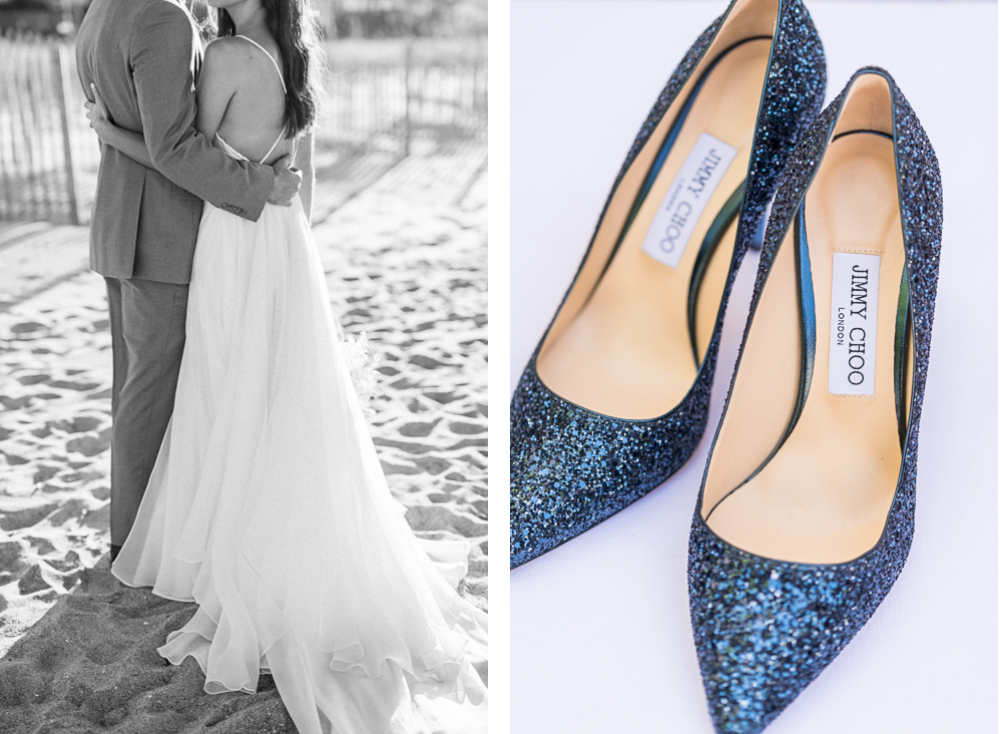
What’s the Deal with Nikon Z Lenses?
When Nikon announced the mirrorless cameras back in 2018, it also made an equally exciting announcement. Because of the way mirrorless cameras are built, the physical limitations of lenses were going to change. For example: up until recently, the fastest autofocus lenses Nikon had ever sold were its series of f/1.4 lenses. And they are fantastic lenses — my 85 mm f/1.4 is BY FAR my most-used lens, even with all the Z-series lenses available as of today. But Nikon recently released the Z-mount 58 mm f/0.95, a larger aperture than we’ve ever seen from Nikon or Canon! But at $8,000, I doubt many photographers will be adding it to their camera bag anytime soon 😅
But anyway, Nikon has come a LONG way with their Z-series lenses since they first announced them a few years back. When we wrote the first version of this article in August of 2020, there were a total of 12 Z-mount lenses for full-frame mirrorless cameras, with another 9 in production. Today, just 15 months later, there are already 22 full-frame lenses for sale on their website, with another 5 in production. They range from the simple $300 kit lens to the $2,000+ ultra-premium prime lens. And to be honest, we own 5 of their new Z-series lenses (three zooms and two primes) and are absolutely THRILLED with the performance of all of them!
However, 22 lenses still pales in comparison to the dozens of F-mount lenses that Nikon has been producing for almost 70 years. Now that mirrorless tech is on the scene, if you stick with DSLR lenses, you can find many of them at a great deal!
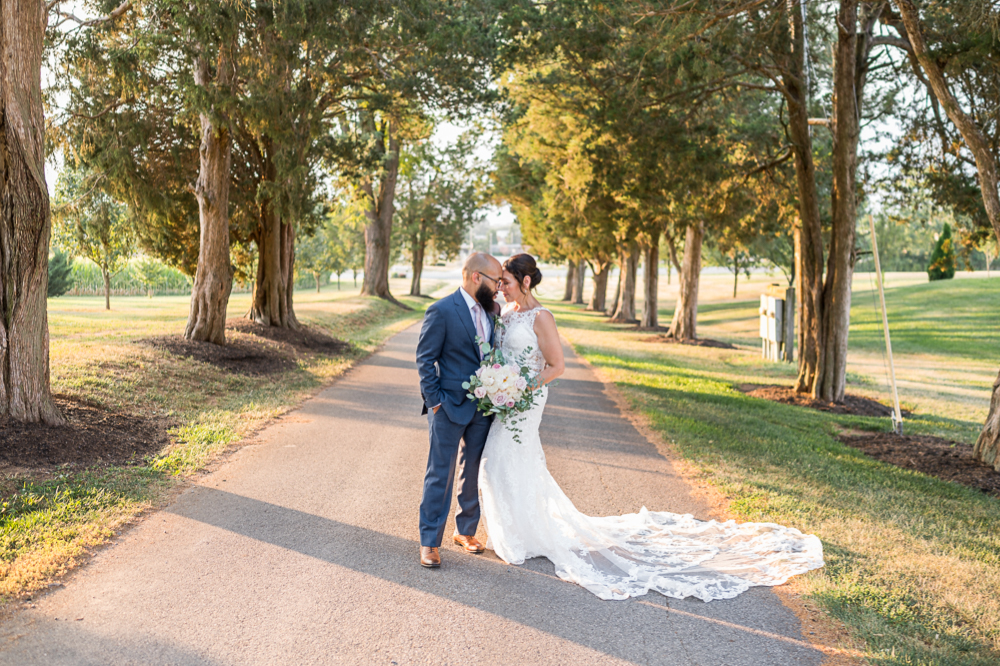
But cost is the other factor to consider. While you can pick up a DSLR 85 mm f/1.8 for less than $500, the Z-mount f/1.8 retails at $800. Likewise, you could purchase a brand new DSLR 50 mm f/1.8 for less than $200, while the Z-mount equivalent is $600 – 3X the cost! The trend continues with most other lenses. You also have to consider that F-mount (DSLR) lenses will work on either DSLR or mirrorless cameras (with an FTZ mount adaptor), but Z-mount lenses will only work on mirrorless cameras. So purchasing a Z-mount lens is a commitment to exclusively work in the mirrorless world.
In summary, when it comes to lenses, if cost is a factor then you may want to stick with a DSLR, or purchase the Z6, but pick up the FTZ and stick with traditional F-mount lenses. If you’ve got the money to spend, and performance is a higher concern for you than cost, then maybe upgrade to Z lenses as you can, as it looks like Nikon (and Canon and Sony) may be done developing new lenses for the traditional DSLR world. Keep in mind that typically, as newer technology becomes more widely adopted, the tech improves while cost simultaneously goes down.
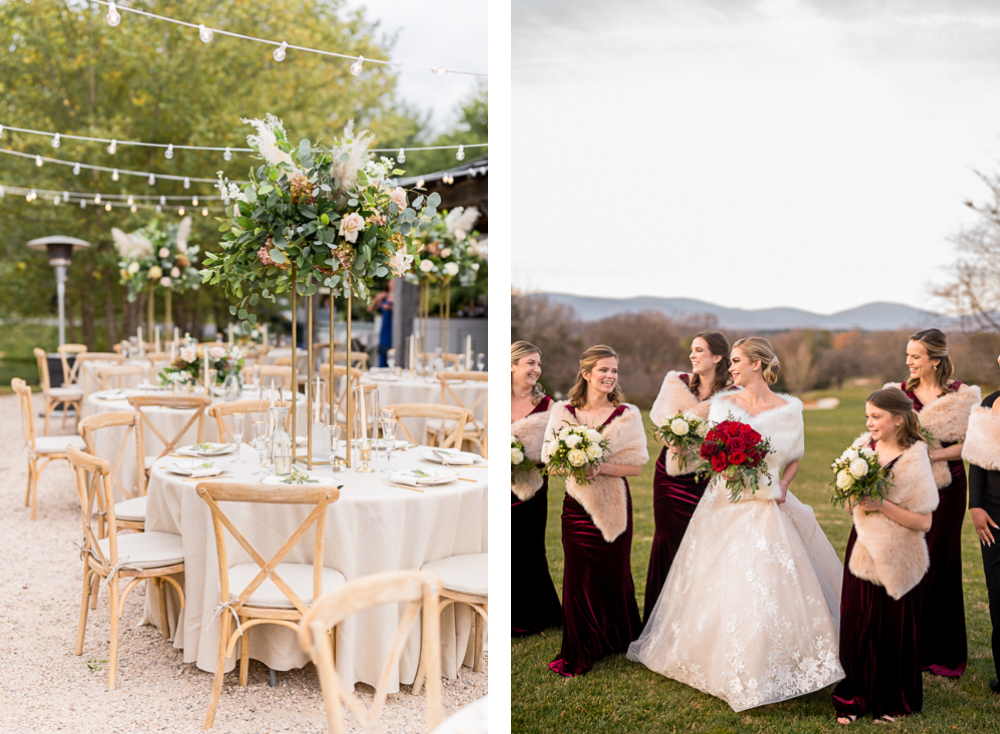
Final thoughts
As far as we see it, all four of these cameras are still great options, but for different photographers. Here’s who we think would benefit most from each camera:
- Nikon D750: If you need the cheapest full-frame camera possible and you want it right now
- Nikon D780: If you have plenty of money to spend, but just can’t get behind the mirrorless world and want to stick with DSLR (and are okay being “left behind” in the coming years)
- Nikon Z6: If you’re ready for mirrorless, and don’t shoot important once-in-a-lifetime moments like weddings, and want to save a little money
- Nikon Z6ii: If you’re ready for mirrorless, and have the extra money to spend and/or you shoot weddings
As best as we can tell, the entire digital photography industry is heading in the mirrorless direction. I would guess that by 2025, most mainstream photographers will look at DSLRs as “old school”, and Nikon and Canon will likely stop producing them altogether in the next few years. So if you’re considering upgrading to your first full-frame camera body, or your current workhorse is ready to be retired, it might be worth saving for a bit longer and making the leap into the mirrorless ecosystem. If cost is no factor at all, then it’s almost a no-brainer to head in the mirrorless direction!
However, if you want to upgrade from a beginner or “pro-sumer” camera to a professional camera body and lenses ASAP, then go with the D750 for now, and save up for the mirrorless tech later on down the road. Honestly, we don’t see why anyone would go for the D780, as you’ll very soon find yourself locked out of new lenses and software updates, while spending a TON of money.
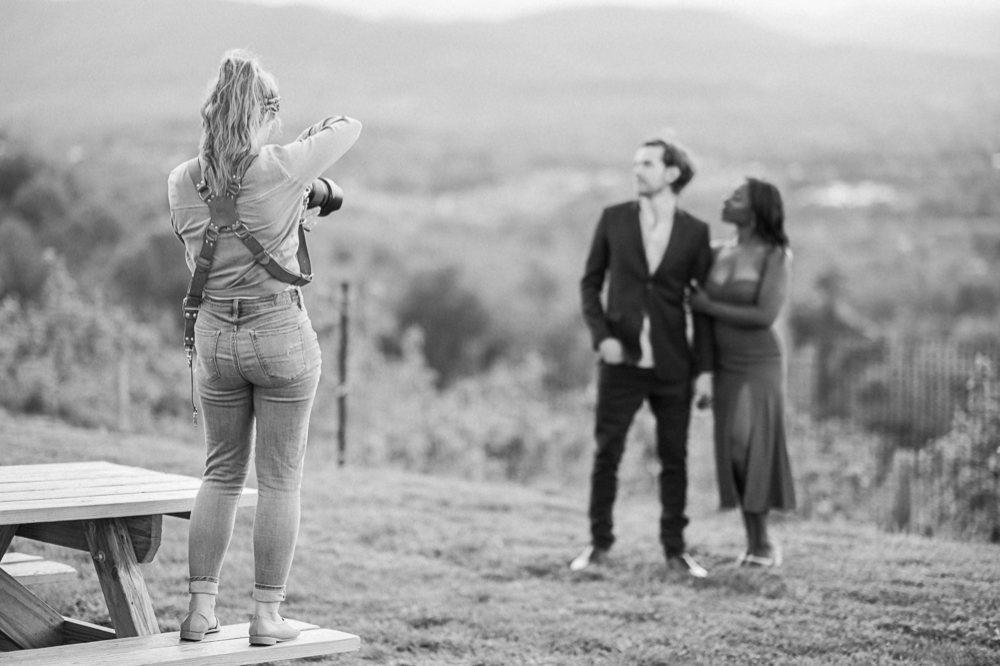
Our Experience
Since Nikon announced the Z6ii in November of 2020, Sarah and I sold both of our D750s and all 3 of our DSLR zoom lenses. We now own three Z6ii cameras, as well as our old Z6, and the “holy trinity” of Nikon’s new Z-series zoom lenses: the 14-24 mm, the 24-70 mm, and the 70-200 mm. Sarah also switched to the 50 mm f/1.2 as her primary lens, which is definitely the nicest lens we’ve ever owned. We’ve fully-embraced the mirrorless world, and if you have the money to do the same, do it!
Want More?
Click HERE to get your free copy of our eBook: “5 Essential Tips for Turning your Side-Hustle into a Full-Time Photography Business.” You’ll also be subscribed to our newsletter, so our newest content, weekly encouragement, and exclusive offers will be delivered right to your inbox!
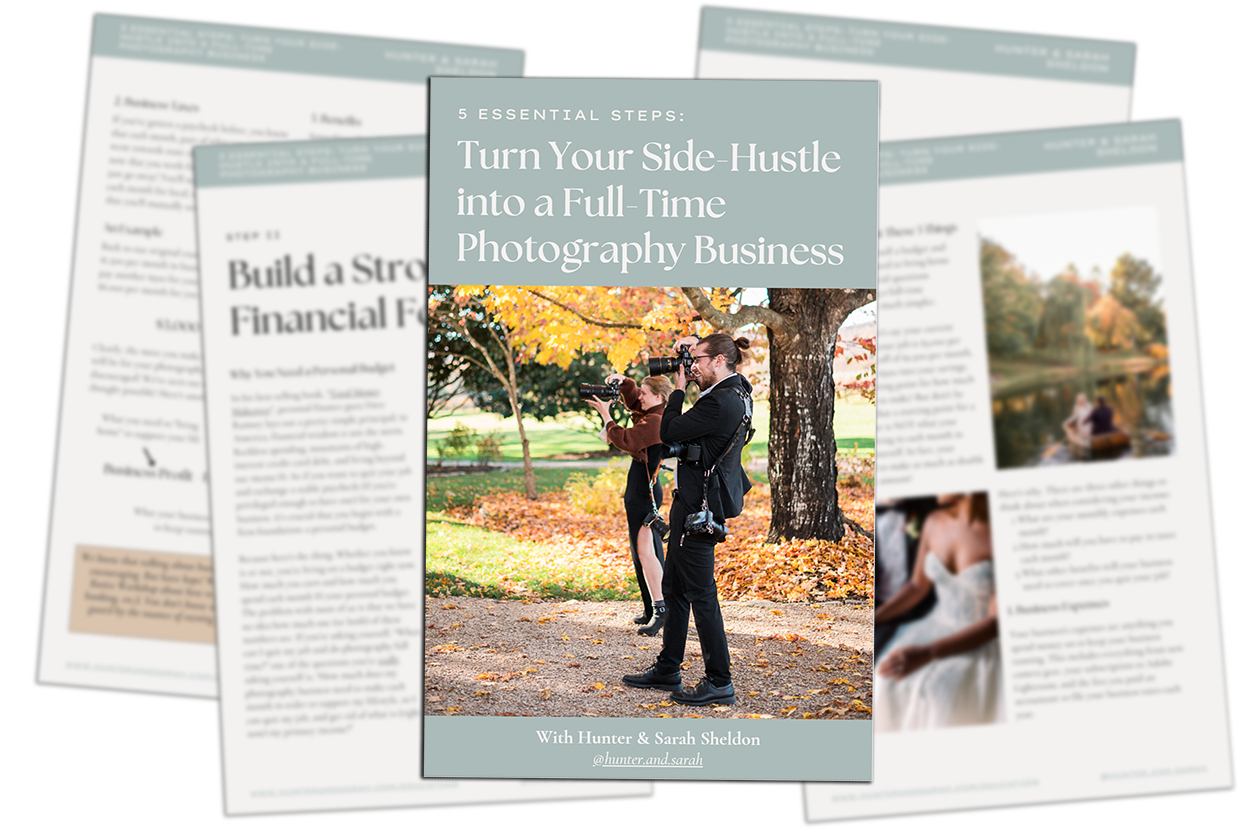
—
Shopping List!
If you’re planning to purchase anything that we talked about today and we helped you make your decision, it would mean SO much to us if you purchased it through the links below! You’ll pay the same price as you normally would on Amazon, but Amazon would share a small slice of the profit with us. You’ll get what you need, support a small local business (us), and show us that our advice really has been helpful! Thanks! [Prices shown as of date of publishing, and are just for comparison/reference]
Mirrorless:
- Nikon Z6 (Body Only) [$1,000]
- Nikon Z6ii (Body Only) [$1,700]
- Nikon FTZ Mount Adaptor [$250]
- Nikon Z 35 mm f/1.8 S [$700]
- Nikon Z 50 mm f/1.8 S [$550]
- Nikon Z 50 mm f/1.2 S [$1,900]
- Nikon Z 85 mm f/1.8 S [$700]
- Nikon Z 14-24 mm f/2.8 S [$2,300]
- Nikon Z 24-70 mm f/2.8 S [$2,100]
- Nikon Z 70-200 mm f/2.8 S [$2,400]
- Sony 120 GB XQD card [$200]
- Sony 120 GB CFExpress card [$200]
- Sony XQD/CFExpress Type B Card Reader [$100]
DSLR:
- Nikon D780 (Body Only) [$2,000]
- Nikon F-mount 35 mm f/1.8 [$475]
- Nikon F-mount 50 mm f/1.8 [$175]
- Nikon F-mount 50 mm f/1.4 [$400]
- Nikon F-mount 85 mm f/1.8 [$425]
- Nikon F-mount 85 mm f/1.4 [$1,450]
- SanDisk 128 GB professional SD [$30]
—
Check out the rest of the series below!
-
- Camera Bag Essentials 0: DSLR vs Mirrorless: Nikon D750 vs Z6 vs Z6ii
- Camera Bag Essentials 1: Prime Lenses: 85mm vs 50mm vs 35mm
- Camera Bag Essentials 2: Wide Angle Lenses: 35mm vs 24-70mm vs 14-24mm
- Camera Bag Essentials 3: Four Reasons to Buy a Telephoto Zoom Lens: The 70-200mm f/2.8
- Camera Bag Essentials 4: How to Up Your Detail-Photo Game with a Macro Lens
- Camera Bag Essentials 5: Using Reflectors and Flashes as a Natural Light Wedding Photographer
- Camera Bag Essentials 6: Why We Used Off-Camera Flash as Wedding Photographers… But Don’t Anymore
- Camera Bag Essentials 7: How to Know When It’s Time to Upgrade Your Camera Body
- Camera Bag Essentials 8: How to Know When You’re Ready for a New Prime Lens
- Camera Bag Essentials 9: Everything You Need to Know to Protect Your Camera Gear
- Camera Bag Essentials 10: 10 Wedding Photography Accessories You Didn’t Know You Needed
Filed in:
Wedding Photography & Photography Education
Charlottesville, Virginia and Beyond
HOME
ABOUT US
WEDDINGS
JOURNAL
FOR PHOTOGRAPHERS
PRESS & PRAISE
BLOG
CONTACT
e. hunter@hunterandsarahphotography.com
p. (434) 260-0902
